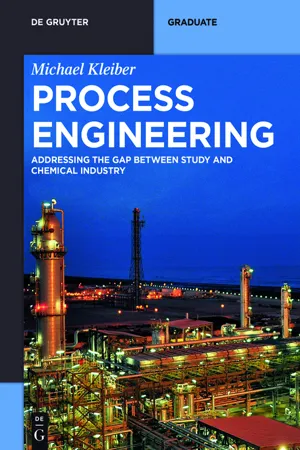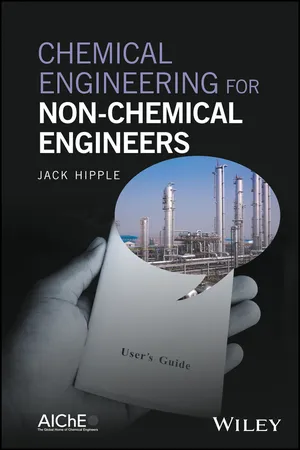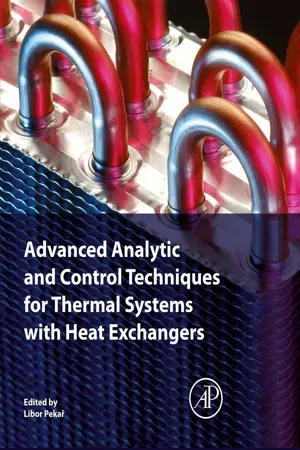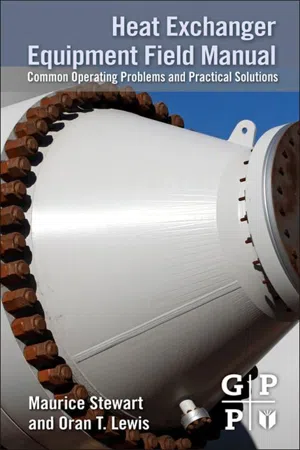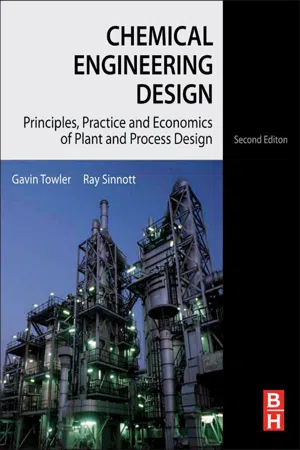Technology & Engineering
Heat Exchanger
A heat exchanger is a device used to transfer heat between two or more fluids that are at different temperatures. It works by allowing the fluids to come into thermal contact without mixing. Heat exchangers are widely used in various industrial and domestic applications, such as in HVAC systems, refrigeration, and power plants, to efficiently manage heat transfer processes.
Written by Perlego with AI-assistance
Related key terms
Related key terms
1 of 4
Related key terms
1 of 3
7 Key excerpts on "Heat Exchanger"
- eBook - ePub
Physics of Cryogenics
An Ultralow Temperature Phenomenon
- Bahman Zohuri(Author)
- 2017(Publication Date)
- Elsevier(Publisher)
Chapter 12Heat Exchangers
Abstract
A Heat Exchanger is a heat transfer device that exchanges heat between two or more process fluids. Heat Exchangers have widespread industrial and domestic applications. Many types of Heat Exchangers have been developed for use in steam power plants, chemical processing plants, building heat and air conditioning systems, transportation power systems, and refrigeration units. The actual design of Heat Exchangers is a complicated problem. It involves more than heat-transfer analysis alone. The cost of fabrication and installation, weight, and size play important roles in the selection of the final design from a total cost of ownership point of view. In many cases, although cost is an important consideration, size and footprint often tend to be the dominant factors in choosing a design.Keywords
Condenser; Construction; Cryogenics; Heat Exchanger; Heat transferOutline12.1 Heat Exchanger Types 12.2 Classification of Heat Exchanger by Construction Type 12.2.1 Tubular Heat Exchangers 12.2.2 Plate Heat Exchangers 12.2.3 Plate Fin Heat Exchangers 12.2.4 Tube Fin Heat Exchangers 12.2.5 Regenerative Heat Exchangers 12.3 Condensers 12.4 Boilers 12.5 Classification According to Compactness 12.6 Types of Applications 12.7 Cooling Towers 12.8 Regenerators and Recuperators 12.9 Heat Exchanger Analysis: Use of the Log Mean Temperature Difference 12.10 Effectiveness-NTU Method for Heat Exchanger Design 12.10.1 Parallel Flow 12.10.2 Counterflow 12.10.3 Crossflow 12.10.3.1 Crossflow— Both Fluids Unmixed 12.10.3.2 Crossflow— One Fluid Mixed 12.10.3.3 Crossflow— Both Fluids Mixed 12.11 Special Operating Conditions 12.12 Compact Heat Exchangers References Further ReadingA Heat Exchanger is a heat transfer device that exchanges heat between two or more process fluids. Heat Exchangers have widespread industrial and domestic applications. Many types of Heat Exchangers have been developed for use in steam power plants, chemical processing plants, building heat and air conditioning systems, transportation power systems, and refrigeration units. The actual design of Heat Exchangers is a complicated problem. It involves more than heat-transfer analysis alone. The cost of fabrication and installation, weight, and size play important roles in the selection of the final design from a total cost of ownership point of view. In many cases, although cost is an important consideration, size and footprint often tend to be the dominant factors in choosing a design. - eBook - ePub
- Andrè Garcia McDonald, Hugh Magande(Authors)
- 2012(Publication Date)
- Wiley(Publisher)
4 Fundamentals of Heat Exchanger Design 4.1 Definition and RequirementsHeat Exchangers are devices that facilitate energy transfer between two fluids at different temperatures while keeping them from mixing with each other. Fundamental knowledge of heat conduction and heat convection are required for Heat Exchanger design and/or selection. Examples of Heat Exchangers include (i) car radiator; (ii) hydronic baseboard heaters; (iii) condensers; (iv) superheaters; (v) boilers; and (vi) regenerators/recurperators.4.2 Types of Heat Exchangers 4.2.1 Double-Pipe Heat ExchangersIn this type of Heat Exchanger, one fluid flows through a pipe and the other fluid flows through an annular space that encloses the pipe. There are two types of flows in double-pipe Heat Exchangers: parallel flow and counter flow. Figure 4.1 shows schematics of double-pipe Heat Exchangers:Parallel flow : Both fluids enter and exit at the same point (ie. fluids flow in the same direction). For very long systems, the temperatures of the two fluids will eventually become equal at the exit.Counter flow : The fluids enter and leave at opposite ends (ie. fluids flow in opposite directions). The flows are in opposite directions. A larger temperature difference exists over the length of this Heat Exchanger compared to the parallel flow Heat Exchanger.4.2.2 Compact Heat ExchangersFigure 4.1 Temperature profiles and schematics of (a) parallel and (b) counter flow double-pipe Heat ExchangersCompact Heat Exchangers were developed to provide large surface areas for heat transfer (per unit volume). A Heat Exchanger is considered compact if the area density ( ) is large. Area density is(4.1)where A s is the surface area and V is the volume.A Heat Exchanger is considered compact if: β > 200 ft2 /ft3 .Cross-flow Heat Exchangers are excellent examples of compact Heat Exchangers. The addition of fins to extend the heat transfer surface area will make the Heat Exchanger more compact. Figure 4.2 shows some cross-flow Heat Exchangers with fins (finned-tube) and without fins (bare). The fins and tubes separate the working fluids into distinct sections, producing unmixed flow . Mixed flow occurs when the working fluid is not separated into smaller subsections (see Figure 4.2 b). Figure 4.3 - eBook - ePub
- Michael Kleiber(Author)
- 2016(Publication Date)
- De Gruyter(Publisher)
4Heat Exchangers Most of the Heat Exchangers do not work because of, but in spite of our design… (Hans Haverkamp)Heating and cooling of streams are essential unit operations in any process. They are usually carried out in so-called Heat Exchangers, and their design is one of the main requirements of a useful process engineering. There are a lot of different aspects that have to be taken into account, and both process and construction engineers must give their input to achieve a good solution.In contrast to academia, the fundamentals of heat transfer play a minor role in industrial applications. The necessary relationships are already integrated in commercial Heat Exchanger programs like HTRI, HTFS, or ASPEN Heat Exchanger Design& Rating. Instead, the focus is the reasonable use of the particular options for the design of the apparatus. It is attempted to give a good explanation of these options in the following chapter; for the fundamentals, there are a lot of other textbooks available, e.g. Baehr/Stephan [71 ] or the VDI Heat Atlas [72 ].There are two main types of apparatuses for heat exchange, the shell-and-tube type and the plate Heat Exchangers. Other types, e.g. spiral Heat Exchanger, double pipes etc., are not or only briefly considered in this book. Much information about them is given in [72 ]. The shell-and-tube type is still the more widely applied because of its robustness and flexibility. It will be discussed in detail, as their specification is a standard task of a process engineer. Plate Heat Exchangers are outlined more briefly; usually, a vendor specialist is necessary to obtain an optimum design.4.1Something general
Heat Exchangers transfer heat from one fluid to another one, the two of which do not come into contact because of a separating wall. The design of a Heat Exchanger is a classical heat transition problem, meaning that the heat has to be transferred from one of the fluids to the separating wall, then go through the wall and finally be transferred from the wall to the second fluid. Fouling layers can make this heat transfer more difficult; they can be considered in the calculation analogously to the separating wall (Figure 4.1 - eBook - ePub
- Jack Hipple(Author)
- 2017(Publication Date)
- Wiley-AIChE(Publisher)
8 Heat Transfer and Heat ExchangersA second major subject for chemical engineering practice is the study of energy transfer, most often the use of equipment to transfer heat, either heating or cooling. We use the term refrigeration when we are discussing cooling below ambient temperatures. We may want to heat or cool for a variety of reasons:- Preheat a material entering a chemical reaction system.
- Cool a process vessel or reaction system that is generating heat in an exothermic reaction.
- Heat a reaction to sustain its reaction if it is an endothermic reaction.
- Condense vapors from an evaporator or distillation column.
- Reboil liquid at the bottom of a distillation column.
- Refrigerate a material that might decompose at a very low temperature in a reaction system. When we are cooling below room temperature, the Heat Exchanger is often referred to as a “chiller.”
- Collect or remove radiative heat. Solar collectors are examples of such devices. High temperature cracking furnaces are another.
The equipment and fluids used in this unit operation vary widely according to the requirements and the resource availability. For example, if it is necessary to cool a material in South Texas to 70°F in the summer, this will not be possible with lake or river water. Some kind of refrigeration will be required. If this same system were in Minnesota or the upper peninsula of Michigan, there would be no such need. Conversely, if there is a need to heat a material, the pressure of the steam available will put limits on what is possible as steam temperature and pressure go hand in hand.As in the other topics we have covered, there are two fundamental principles that we need to remember:- Heat flows from high temperature to low temperature.
- Heating or cooling can be used to increase or decrease the temperature of a material or to change its phase, that is, melt/freeze or boil/condense. When a material is undergoing a phase change, there is no change in temperature.
- Libor Pekar(Author)
- 2020(Publication Date)
- Academic Press(Publisher)
Section 1 Fundamentals of Heat ExchangersPassage contains an image
Chapter 1Introduction to Heat Exchangers
Libor Pekař Faculty of Applied Informatics, Department of Automation and Control Engineering, Tomas Bata University in Zlín, Zlín, Czech RepublicAbstract
This concise introductory chapter is aimed at providing an unacquainted reader with very basic essentials about Heat Exchangers. There are two main parts of this chapter. Namely, the definition of Heat Exchangers and several possible classifications are given first. Afterward, the reader is acquainted with some basic mathematical laws that model the behavior and heat transfer of a general Heat Exchanger. References to various literature resources are provided so the reader can find more detail therein.Keywords
Classification; Fourier's law; Heat Exchangers; Heat Exchanger construction; Heat Exchanger types; Heat transfer rate; Logarithmic mean temperature difference; Newton's cooling law1 Introduction
This concise introductory chapter is aimed at providing an unacquainted reader with very basic essentials about Heat Exchangers (HXs). It is definitely not intended to be exhaustive. There are two main parts of this chapter. Namely, the definition of HXs and several possible classifications are given first. Afterward, the reader is acquainted with some basic mathematical laws that model the behavior and heat transfer of a general HX. References to various literature resources are provided so the reader can find more detail therein.A HX is a heat transfer device that exchanges heat between two or more process fluids, at different temperatures, and in thermal contact [1 –3 ]. In HXs, heat transfer takes place from a high-temperature fluid to a low-temperature fluid. Usually, the phase of the fluids is not changed during the heat transfer. Besides heat conduction, thermal convection and radiation apply, which indicates that it is a complex process. HXs have many domestic and industrial applications, such as in building heat and air conditioning systems, refrigeration units, steam power plants, chemical processing plants, transportation power systems, etc. [3]- eBook - ePub
Heat Exchanger Equipment Field Manual
Common Operating Problems and Practical Solutions
- Maurice Stewart, Oran T. Lewis(Authors)
- 2012(Publication Date)
- Gulf Professional Publishing(Publisher)
Chapter 2
Heat Exchanger Configurations
Overview
Heat Exchangers used in oil and gas facilities are configured as followsBath heaters Direct Indirect Fluid–fluid Shell and tube Double pipe Plate and frame Coolers using air Air-cooled exchangers Cooling towersThe remainder of this section discusses basic concepts in sizing and selecting Heat ExchangersShell-and-tube exchangers
Tubular Exchanger Manufacturers Association (TEMA)
Defines the various types of shell and tube exchangers Defines design and construction practices TEMA classesClass “C” —Less stringent, used onshore, and temperatures above − 20°FClass “R” —Offshore and cold temperature serviceCommon Services
Liquid–liquid Liquid–vapor Vapor–vaporComponents (Figures 2.1 and 2.2 )
Shell with two nozzlesFigure 2.1 Components of shell-and-tube exchangers.Figure 2.2 Cutaway of two shell-and-tube Heat Exchangers.Tube sheets Heads Transverse bafflesConfiguration Considerations
Fluids involved Corrosion potential Problems of cleaning Pressure drop Heat transfer efficiency Heat Exchangers selection is not routine Tube lengths 20 ft 40 ftBaffles
Directs the flow of both tube-side and shell-side fluids (Figures 2.3 –2.6 )Figure 2.3 Exchanger baffles.Figure 2.4 Shell-and-tube baffles—Helical baffles.Figure 2.5 Shell-and-tube baffles—Helical baffles.Figure 2.6 Shell-side flow paths.Pass PartitionForces fluid to flow through several groups of parallel tubesIncreases number of passes Two-pass fixed exchanger Tube fluid passes through fraction of tubes Maintains high tube velocity Increases heat transfer Impingement Placed opposite shell-side inlet nozzle Disperses fluid around tubes Prevents impingement and erosion of tubesTransverse or support (Figures 2.7 –2.10 )Support the tubes that pass through holes in the bafflesMaintains turbulence - eBook - ePub
Chemical Engineering Design
Principles, Practice and Economics of Plant and Process Design
- Gavin Towler, Ray Sinnott(Authors)
- 2012(Publication Date)
- Butterworth-Heinemann(Publisher)
Chem Eng., NY . 1980;87(August 11):133.99. Richardson JF, Harker JH, Backhurst J. Chemical engineering . Vol. 2 3rd ed. Butterworth-Heinemann 2002.100. Rohsenow WM, Hartnett JP, Cho YL, eds. Handbook of heat transfer . McGraw-Hill 1998.101. Rubin FL. Design of air cooled Heat Exchangers. Chem Eng., NY . 1960;67(October 31st):91.102. Sarma NVLS, Reddy PJ, Murti PS. A computer design method for vertical thermosiphon reboilers. Ind Eng Chem Proc Des Dev. 1973;12:278.103. Saunders EAD. Heat Exchangers Longmans 1988.104. Schlunder EU, ed. Heat Exchanger design handbook . Hemisphere 1983; [5 vols. with supplements].105. Shah MM. A new correlation for heat transfer during boiling flow through tubes. ASHRAE Trans. 1976;82(Part 2):66.106. Shellene KR, Sternling CV, Church DM, Snyder NH. An experimental study of vertical thermosiphon reboilers. Chem Eng Prog Symp Ser. 1968;64(82):102.107. Sieder EN, Tate GE. Heat transfer and pressure drop of liquids in tubes. Ind Eng Chem. 1936;28:1429.108. Silver L. Gas cooling with aqueous condensation. Trans Inst Chem Eng. 1947;25:30.109. Singh KP, Soler AI. Mechanical design of Heat Exchanger and pressure vessel components Springer-Verlag 1992.110. Steinmeyer DE. Fog formation in partial condensers. Chem Eng Prog. 1972;68(July):64.111. Taborek J. Design methods for heat-transfer equipment: A critical survey of the state of the art. In: Afgan N, Schlunder EV, eds. Heat Exchangers: Design and theory source book . McGraw-Hill 1974.112. Taborek J, Aoki T, Ritter RB, Palen JW. Fouling: The major unresolved problem in heat transfer. Chem Eng Prog. 1972;68 59, (July] 69 (in two parts].113. Tinker T. Shell-side characteristics of shell and tube Heat Exchangers . Proceedings of the general discussion on heat transfer London: Institution of Mechanical Engineers; 1951; [p. 89].114. Tinker T. Shell-side characteristics of shell and tube exchangers. Trans Am Soc Mech Eng.
Index pages curate the most relevant extracts from our library of academic textbooks. They’ve been created using an in-house natural language model (NLM), each adding context and meaning to key research topics.
Explore more topic indexes
Explore more topic indexes
1 of 6
Explore more topic indexes
1 of 4


